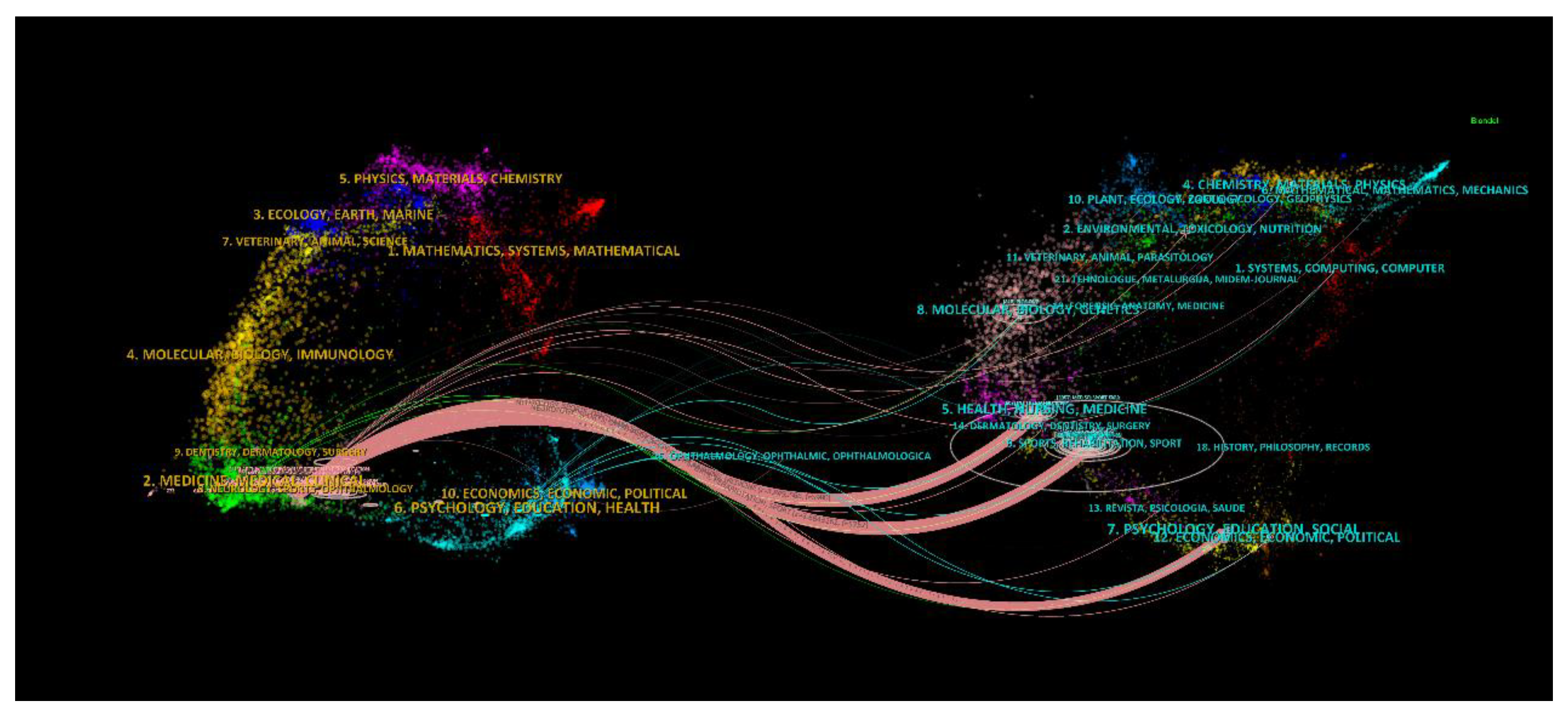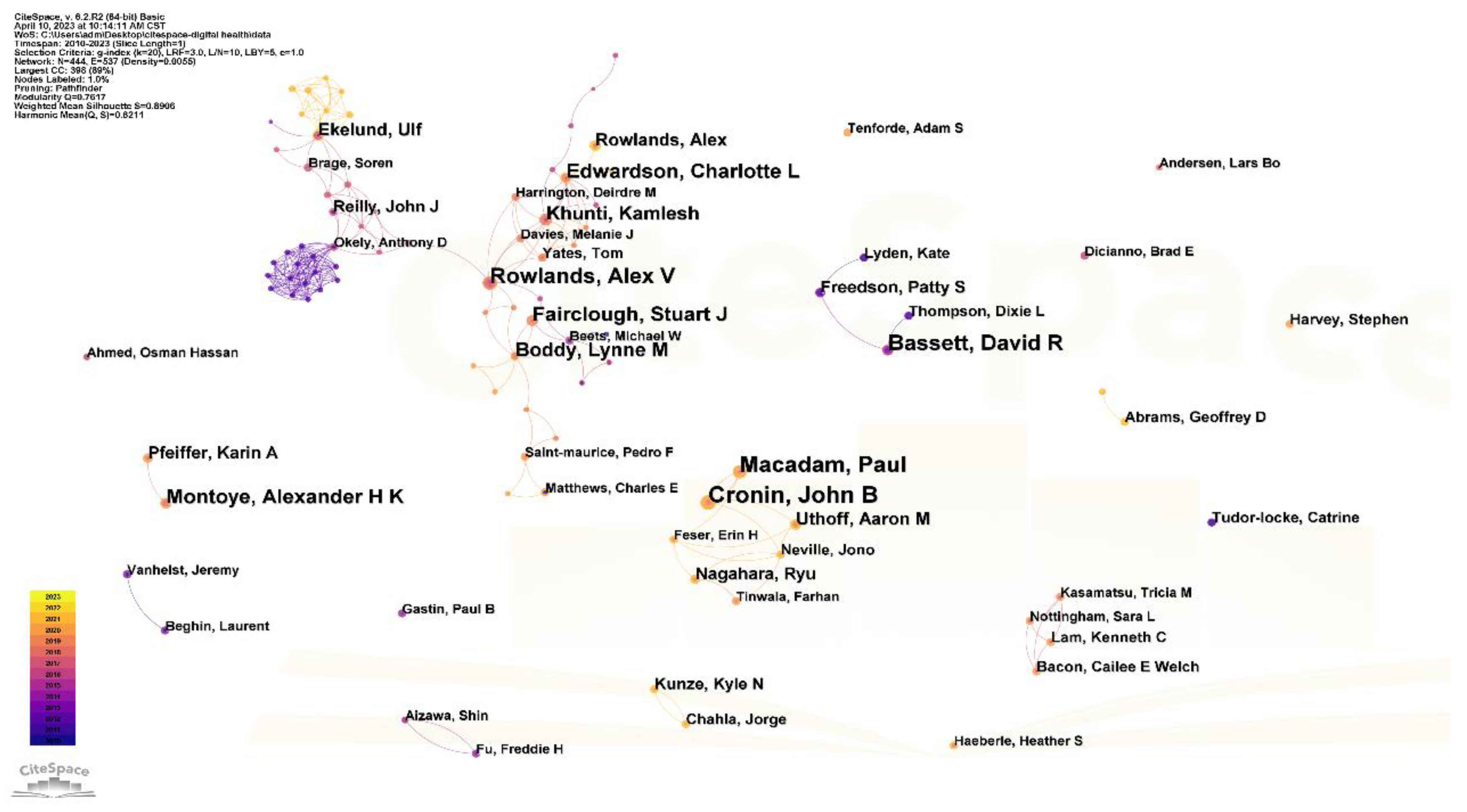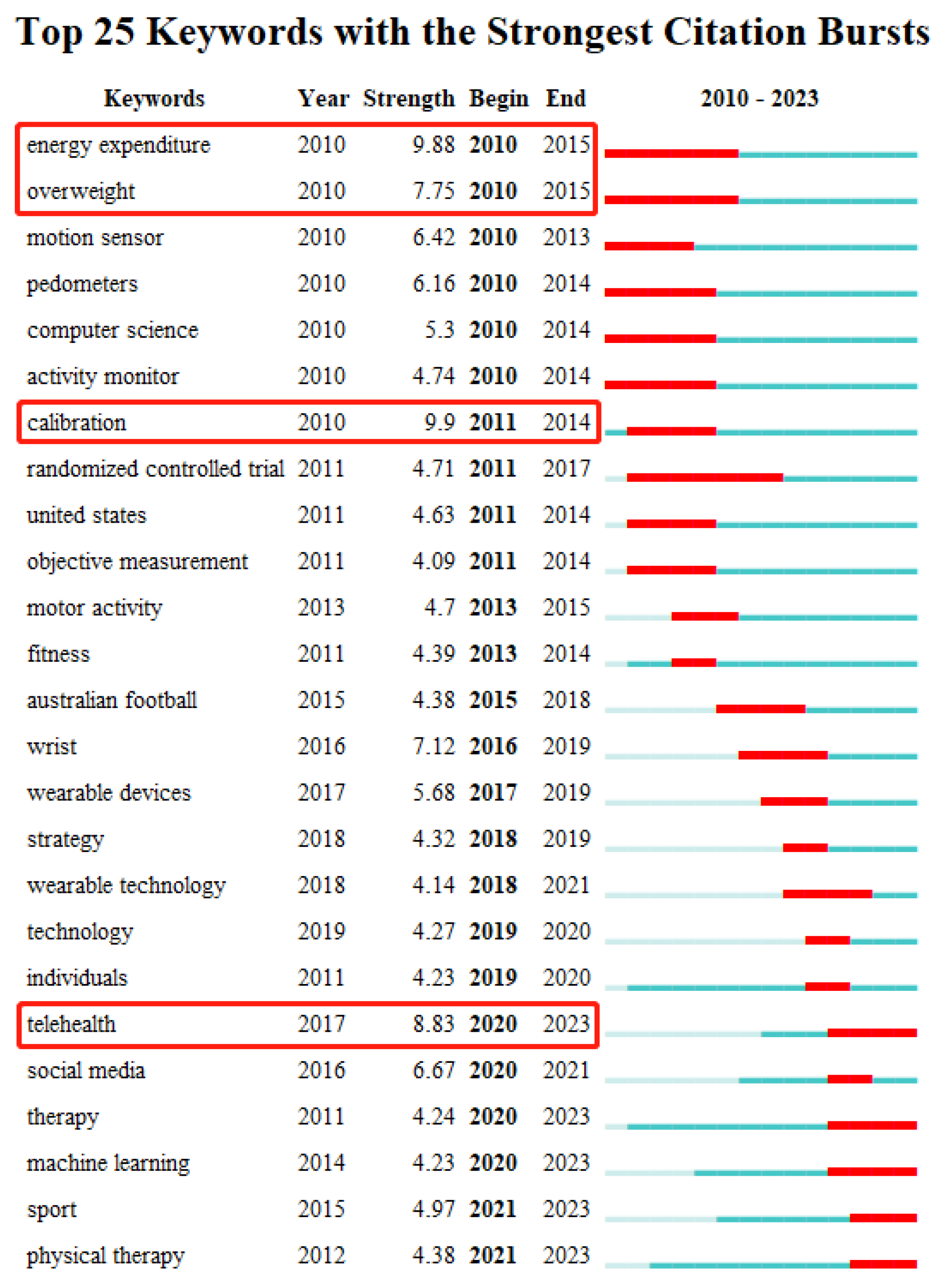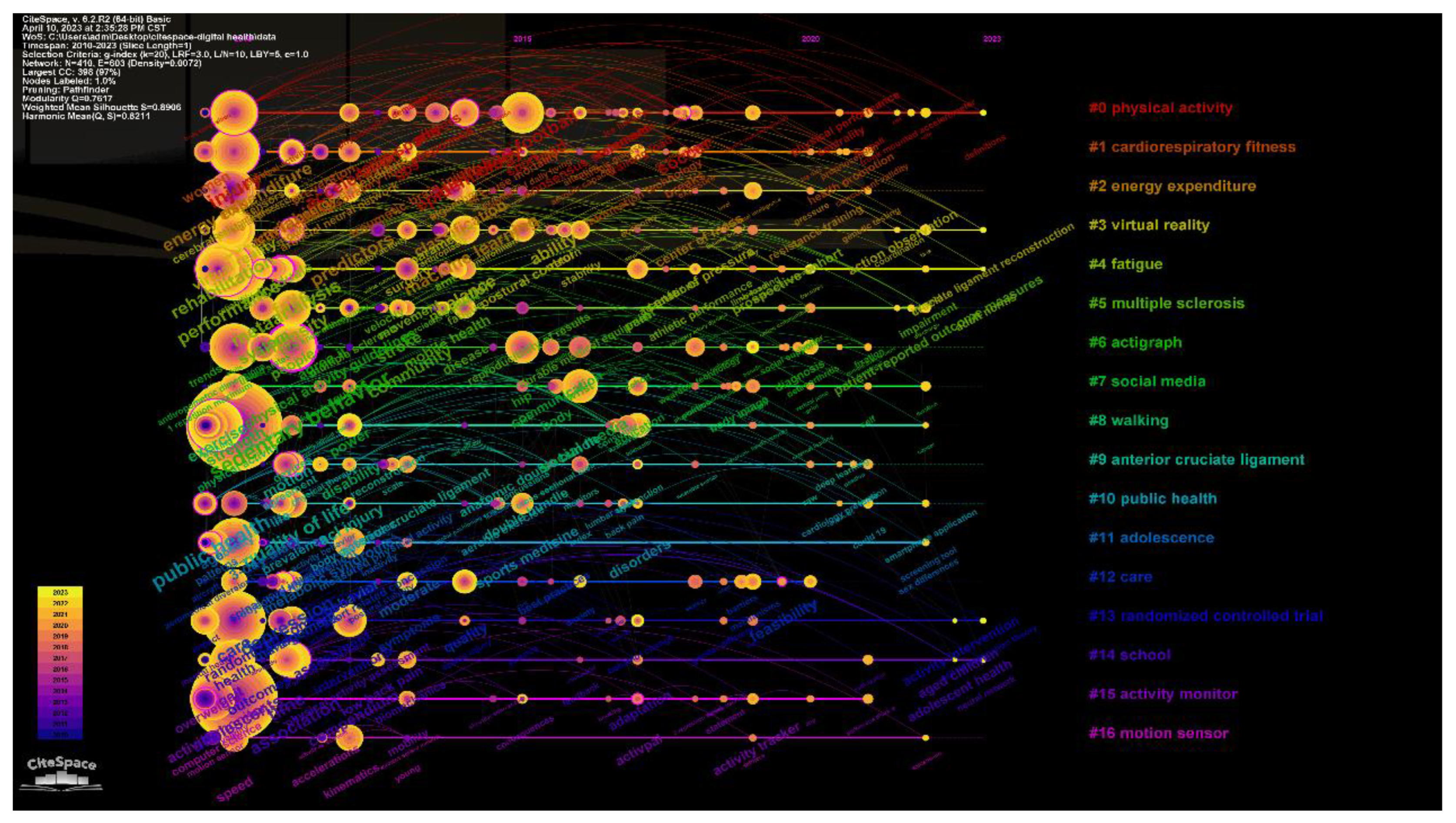Submitted:
30 May 2023
Posted:
01 June 2023
You are already at the latest version
Abstract
Keywords:
1. Introduction
2. Materials and Methods
2.1. Search Strategy and Data Collection
2.2. Analysis Method
2.3. Software Parameters Description
3. Results
3.1. Annual Trends of Publications
3.2. Distribution of Published Journals
3.3. Country Cooperation Network
3.4. Institutional Cooperation Network
3.5. Author Collaboration Network
3.6. Keyword co-occurrence and burst analysis
3.7. Keyword Clustering Analysis
3.8. Analysis of Keyword Timeline Graphs
4. Discussion
5. Research Strengths and Limitations
6. Conclusion
Author Contributions
Funding
Institutional Review Board Statement
Informed Consent Statement
Data Availability Statement
Acknowledgements
Conflicts of Interest
References
- Rahman A, Hossain MS, Muhammad G, Kundu D, Debnath T, Rahman M, Khan MSI, Tiwari P, Band SS. Federated learning-based AI approaches in smart healthcare: concepts, taxonomies, challenges and open issues. Cluster Comput 2022.
- Wang YH, Lin GY. Exploring AI-healthcare innovation: natural language processing-based patents analysis for technology-driven roadmapping. Kybernetes 2023, 52, 1173–1189. [Google Scholar] [CrossRef]
- Aung YYM, Wong DCS, Ting DN. The promise of artificial intelligence: a review of the opportunities and challenges of artificial intelligence in healthcare. Brit Med Bull 2021, 139, 4–15. [Google Scholar] [CrossRef] [PubMed]
- Hellmann A, Emmons A, Prime MS, Paranjape K, Heaney DL. Digital Health Today’s Solutions and Tomorrow’s Impact. Clin Lab Med 2023, 43, 71–86. [Google Scholar]
- Ozdemir, V. The Big Picture on the “AI Turn” for Digital Health: The Internet of Things and Cyber-Physical Systems. Omics 2019, 23, 308–311. [Google Scholar] [CrossRef]
- Herold F, Theobald P, Gronwald T, Rapp MA, Müller NG. Going digital – a commentary on the terminology used at the intersection of physical activity and digital health. Eur Rev Aging Phys A 2022, 19, 17. [Google Scholar] [CrossRef]
- Moulin, T. Discussion about the presentation “Digital health - Telemedicine: Evidence of university training for all health professionals”. B Acad Nat Med Paris 2022, 206, 684–686. [Google Scholar]
- Gibbs J, Solomon D, Jackson L, Mullick S, Burns F, Shahmanesh M. Measuring and evaluating sexual health in the era of digital health: challenges and opportunities. Sex Health 2022, 19, 336–345. [Google Scholar]
- Fadahunsi KP, O’Connor S, Akinlua JT, Wark PA, Gallagher J, Carroll C, Car J, Majeed A, O’Donoghue J. Information Quality Frameworks for Digital Health Technologies: Systematic Review. J Med Internet Res 2021, 23. [Google Scholar]
- Rigamonti L, Albrecht UV, Lutter C, Tempel M, Wolfarth B, Back DA, Digitalisation WG. Potentials of Digitalization in Sports Medicine: A Narrative Review. Curr Sport Med Rep 2020, 19, 157–163. [Google Scholar] [CrossRef]
- Donthu N, Kumar S, Mukherjee D, Pandey N, Lim WM. How to conduct a bibliometric analysis: An overview and guidelines. Journal of Business Research 2021, 133, 285–296. [Google Scholar] [CrossRef]
- Merigo JM, Cancino CA, Coronado F, Urbano D. Academic research in innovation: a country analysis. Scientometrics 2016, 108, 559–593. [Google Scholar] [CrossRef]
- Labrique A, Agarwal S, Tamrat T, Mehl G. WHO Digital Health Guidelines: a milestone for global health. Npj Digital Medicine 2020, 3, 120. [Google Scholar] [CrossRef] [PubMed]
- Tremblay MS, Carson V, Chaput JP, Gorber SC, Dinh T, Duggan M, Faulkner G, Gray CE, Gruber R, Janson K, Janssen I, Katzmarzyk PT, Kho ME, Latimer-Cheung AE, LeBlanc C, Okely AD, Olds T, Pate RR, Phillips A, Poitras VJ, Rodenburg S, Sampson M, Saunders TJ, Stone JA, Stratton G, Weiss SK, Zehr L. Canadian 24-Hour Movement Guidelines for Children and Youth: An Integration of Physical Activity, Sedentary Behaviour, and Sleep. Appl Physiol Nutr Me 2016, 41, S311–S327. [Google Scholar] [CrossRef]
- Chaput JP, Willumsen J, Bull F, Chou R, Ekelund U, Firth J, Jago R, Ortega FB, Katzmarzyk PT. 2020 WHO guidelines on physical activity and sedentary behaviour for children and adolescents aged 5-17years: summary of the evidence. International Journal of Behavioral Nutrition and Physical Activity 2020, 17. [Google Scholar]
- Lawman HG, Van Horn ML, Wilson DK, Pate RR. A multilevel approach to examining time-specific effects in accelerometer-assessed physical activity. J Sci Med Sport 2015, 18, 667–672. [Google Scholar] [CrossRef]
- Jones MA, Skidmore PM, Stoner L, Harrex H, Saeedi P, Black K, Gibbs BB. Associations of accelerometer-measured sedentary time, sedentary bouts, and physical activity with adiposity and fitness in children. J Sport Sci 2020, 38, 114–120. [Google Scholar] [CrossRef]
- Lyu S, Freivalds A, Downs DS, Piazza SJ. Assessment of postural sway with a pendant-mounted wearable sensor. Gait Posture 2022, 92, 199–205. [Google Scholar] [CrossRef]
- Schumacher BT, Bellettiere J, LaMonte MJ, Evenson KR, Di CZ, Lee IM, Sleet DA, Eaton CB, Lewis CE, Margolis KL, Tinker LF, LaCroix AZ. Accelerometer-Measured Daily Steps, Physical Function, and Subsequent Fall Risk in Older Women: The Objective Physical Activity and Cardiovascular Disease in Older Women Study. J Aging Phys Activ 2022, 30, 635–645. [Google Scholar]
- Sveinson K, Allison R. ?Something Seriously Wrong With US Soccer?: A Critical Discourse Analysis of Consumers? Twitter Responses to US Soccer?s Girls? Apparel Promotion. J Sport Manage 2022, 36, 446–458. [Google Scholar] [CrossRef]
- Juengst SB, Wright B, Sander AM, Preminger S, Nabasny A, Terhorst L. The Behavioral Assessment Screening Tool for Mobile Health (BASTmHealth): Development and Compliance in 2 Weeks of Daily Reporting in Chronic Traumatic Brain Injury. Arch Phys Med Rehab 2023, 104, 203–210. [Google Scholar] [CrossRef] [PubMed]
- Fisher LB, Curtiss JE, Klyce DW, Perrin PB, Juengst SB, Gary KW, Niemeier JP, Hammond FM, Bergquist TF, Wagner AK, Rabinowitz AR, Giacino JT, Zafonte RD. Using Machine Learning to Examine Suicidal Ideation After Traumatic Brain Injury A Traumatic Brain Injury Model Systems National Database Study. Am J Phys Med Rehab 2023, 102, 137–143. [Google Scholar] [CrossRef] [PubMed]
- Maeyama A, Hoshino Y, Debandi A, Kato Y, Saeki K, Asai S, Goto B, Smolinski P, Fu FH. Evaluation of rotational instability in the anterior cruciate ligament deficient knee using triaxial accelerometer: a biomechanical model in porcine knees. Knee Surg Sport Tr A 2011, 19, 1233–1238. [Google Scholar] [CrossRef]
- Carey L, Terry DP, McIntosh AS, Stanwell P, Iverson GL, Gardner AJ. Video Analysis and Verification of Direct Head Impacts Recorded by Wearable Sensors in Junior Rugby League Players. Sports Med-Open 2021, 7.
- Kwon JY, Chacko AT, Kadzielski JJ, Appleton PT, Rodriguez EK. A novel methodology for the study of injury mechanism: ankle fracture analysis using injury videos posted on YouTube.com. J Orthop Trauma 2010, 24, 477–482. [Google Scholar] [CrossRef]
- Martin SD, Abraham PF, Varady NH, Nazal MR, Conaway W, Quinlan NJ, Alpaugh K. Hip Arthroscopy Versus Physical Therapy for the Treatment of Symptomatic Acetabular Labral Tears in Patients Older Than 40 Years: A Randomized Controlled Trial. The American Journal of Sports Medicine 2021, 49, 1199–1208. [Google Scholar] [CrossRef]
- Mercier HW, Hamner JW, Torous J, Onnela JP, Taylor JA. Digital Phenotyping to Quantify Psychosocial Well-Being Trajectories After Spinal Cord Injury. Am J Phys Med Rehab 2020, 99, 1138–1144. [Google Scholar] [CrossRef]
- Rowlands AV, Maylor B, Dawkins NP, Dempsey PC, Edwardson CL, Soczawa-Stronczyk AA, Bocian M, Patterson MR, Yates T. Stepping up with GGIR: Validity of step cadence derived from wrist-worn research-grade accelerometers using the verisense step count algorithm. J Sport Sci 2022, 40, 2182–2190. [Google Scholar] [CrossRef]
- Migueles JH, Aadland E, Andersen LB, Brond JC, Chastin SF, Hansen BH, Konstabel K, Kvalheim OM, McGregor DE, Rowlands AV, Sabia S, van Hees VT, Walmsley R, Ortega FB, Grp ER. GRANADA consensus on analytical approaches to assess associations with accelerometer-determined physical behaviours (physical activity, sedentary behaviour and sleep) in epidemiological studies. Brit J Sport Med 2022, 56, 376–384. [Google Scholar] [CrossRef]
- Manas A, Cruz BD, Ekelund U, Reyna JL, Gomez IR, Carreno JAC, Manas LR, Garcia FJG, Ara I. Association of accelerometer-derived step volume and intensity with hospitalizations and mortality in older adults: A prospective cohort study. Journal of Sport and Health Science 2022, 11, 578–585. [Google Scholar] [CrossRef]
- Perri T, Reid M, Murphy A, Howle K, Duffield R. Differentiating Stroke and Movement Accelerometer Profiles to Improve Prescription of Tennis Training Drills. J Strength Cond Res 2023, 37, 646–651. [Google Scholar] [CrossRef] [PubMed]
- Costello N, Deighton K, Cummins C, Whitehead S, Preston T, Jones B. Isolated & Combined Wearable Technology Underestimate the Total Energy Expenditure of Professional Young Rugby League Players; A Doubly Labelled Water Validation Study. J Strength Cond Res 2022, 36, 3398–3403. [Google Scholar]
- Mirelman A, Patritti BL, Bonato P, Deutsch JE. Effects of virtual reality training on gait biomechanics of individuals post-stroke. Gait Posture 2010, 31, 433–437. [Google Scholar] [CrossRef] [PubMed]
- Phillips LRS, Parfitt G, Rowlands AV. Calibration of the GENEA accelerometer for assessment of physical activity intensity in children. J Sci Med Sport 2013, 16, 124–128. [Google Scholar] [CrossRef] [PubMed]
- Edwardson CL, Rowlands AV, Bunnewell S, Sanders J, Esliger DW, Gorely T, O’Connell S, Davies MJ, Khunti K, Yates T. Accuracy of Posture Allocation Algorithms for Thigh- and Waist-Worn Accelerometers. Medicine & Science in Sports & Exercise 2016, 48, 1085–1090. [Google Scholar]
- Boyd LJ, Ball K, Aughey RJ. The Reliability of MinimaxX Accelerometers for Measuring Physical Activity in Australian Football. Int J Sport Physiol 2011, 6, 311–321. [Google Scholar]
- Maddocks M, Petrou A, Skipper L, Wilcock A. Validity of three accelerometers during treadmill walking and motor vehicle travel. Brit J Sport Med 2010, 44, 606–U631. [Google Scholar] [CrossRef]
- John D, Tyo B, Bassett DR. Comparison of Four ActiGraph Accelerometers during Walking and Running. Med Sci Sport Exer 2010, 42, 368–374. [Google Scholar] [CrossRef]
- Janssen I, Sachlikidis A. Validity and reliability of intra-stroke kayak velocity and acceleration using a GPS-based accelerometer. Sport Biomech 2010, 9, 47–56. [Google Scholar] [CrossRef]
- Fuller D, Anaraki JR, Simango B, Rayner M, Dorani F, Bozorgi A, Luan H, Basset FA. Predicting lying, sitting, walking and running using Apple Watch and Fitbit data. Bmj Open Sport Exerc 2021, 7. [Google Scholar]
- Viciana J, Casado-Robles C, Guijarro-Romero S, Mayorga-Vega D. Are Wrist-Worn Activity Trackers and Mobile Applications Valid for Assessing Physical Activity in High School Students? Wearfit Study. J Sport Sci Med 2022. [Google Scholar]
- Lawrason SVC, Ginis KAM. Evaluating the Feasibility, Acceptability, and Engagement of an mHealth Physical Activity Intervention for Adults With Spinal Cord Injury Who Walk: A Randomized Controlled Trial. J Sport Exercise Psy 2023, 45, 61–76. [Google Scholar] [CrossRef] [PubMed]
- Jacobsson J, Kowalski J, Timpka T, Hansson PO, Spreco A, Dahlstrom O. Universal prevention through a digital health platform reduces injury incidence in youth athletics (track and field): a cluster randomised controlled trial. Brit J Sport Med 2022.
- Llorens R, Noe E, Colomer C, Alcaniz M. Effectiveness, Usability, and Cost-Benefit of a Virtual Reality-Based Telerehabilitation Program for Balance Recovery After Stroke: A Randomized Controlled Trial. Arch Phys Med Rehab 2015, 96, 418–425. [Google Scholar] [CrossRef]
- Nuss K, Moore K, Marchant T, Courtney JB, Edwards K, Sharp JL, Nelson TL, Li KG. The combined effect of motivational interviewing and wearable fitness trackers on motivation and physical activity in inactive adults: A randomized controlled trial. J Sport Sci 2023, 41, 45–55. [Google Scholar] [CrossRef] [PubMed]
- Ozer AY, Senocak E, Aybey BN, Tolmaci L, Surmeli S, Ozmen I, Polat MG. The Effects of the Hybrid Telerehabilitation Exercise Program in Inactive University Students during COVID-19 Pandemic - A Randomized Controlled Study. Phys Med Rehab Kuror 2023, 33, 33–40. [Google Scholar] [CrossRef]
- McDonough DJ, Helgeson MA, Liu WX, Gao Z. Effects of a remote, YouTube-delivered exercise intervention on young adults’ physical activity, sedentary behavior, and sleep during the COVID-19 pandemic: Randomized controlled trial. Journal of Sport and Health Science 2022, 11, 145–156. [Google Scholar] [CrossRef]
- Williams RA, Dring KJ, Morris JG, Sun FH, Cooper SB. Agreement and equivalence of estimated physical activity behaviours, using ENMO- and counts-based processing methods, for wrist-worn accelerometers in adolescents. J Sport Sci 2022, 40, 2499–2508. [Google Scholar] [CrossRef]
- Marcotte RT, Petrucci GJ, Cox MF, Freedson PS, Staudenmayer JW, Sirard JR. Estimating Sedentary Time from a Hip- and Wrist-Worn Accelerometer. Med Sci Sport Exer 2020, 52, 225–232. [Google Scholar] [CrossRef]
- Lerebourg L, Saboul D, Clemencon M, Coquart JB. Prediction of Marathon Performance using Artificial Intelligence. Int J Sports Med 2023, 44, 352–360. [Google Scholar] [CrossRef]
- Soltani P, Morice AHP. A multi-scale analysis of basketball throw in virtual reality for tracking perceptual-motor expertise. Scand J Med Sci Spor 2023, 33, 178-188.
- Gajarawala SN, Pelkowski JN. Telehealth Benefits and Barriers. Jnp-J Nurse Pract 2021, 17, 218–221. [Google Scholar] [CrossRef] [PubMed]
- Onks CA, Wawrzyniak J. The Physical Therapy Prescription. Med Clin N Am 2014, 98, 869–+. [Google Scholar] [CrossRef] [PubMed]
- Ramkumar PN, Luu BC, Haeberle HS, Karnuta JM, Nwachukwu BU, Williams RJ. Sports Medicine and Artificial Intelligence: A Primer. Am J Sport Med 2022, 50, 1166–1174. [Google Scholar] [CrossRef]











| Rank | Publication | Year | Author |
|---|---|---|---|
| 1 | 17 | 2017 | Cronin, John B |
| 2 | 16 | 2017 | Macadam, Paul |
| 3 | 14 | 2010 | Bassett, David R |
| 4 | 14 | 2016 | Rowlands, Alex V |
| 5 | 12 | 2016 | Edwardson, Charlotte L |
| 6 | 11 | 2016 | Fairclough, Stuart J |
| 7 | 11 | 2017 | Montoye, Alexander H K |
| 8 | 10 | 2016 | Boddy, Lynne M |
| 9 | 9 | 2016 | Khunti, Kamlesh |
| 10 | 8 | 2018 | Rowlands, Alex |
Disclaimer/Publisher’s Note: The statements, opinions and data contained in all publications are solely those of the individual author(s) and contributor(s) and not of MDPI and/or the editor(s). MDPI and/or the editor(s) disclaim responsibility for any injury to people or property resulting from any ideas, methods, instructions or products referred to in the content. |
© 2023 by the authors. Licensee MDPI, Basel, Switzerland. This article is an open access article distributed under the terms and conditions of the Creative Commons Attribution (CC BY) license (http://creativecommons.org/licenses/by/4.0/).





